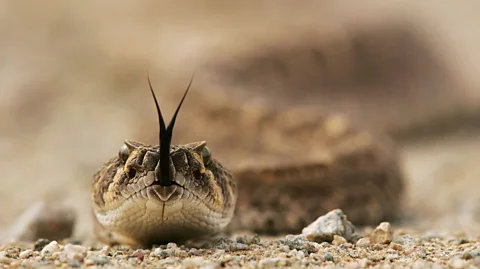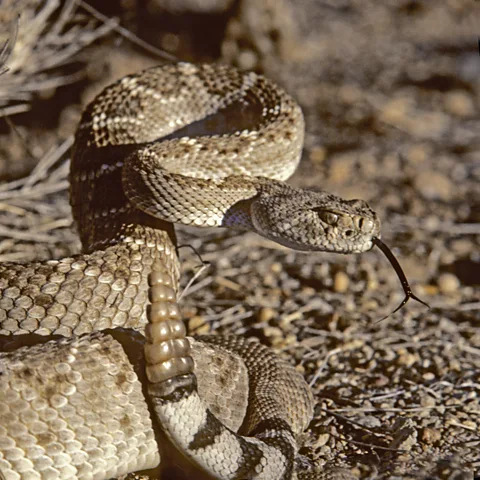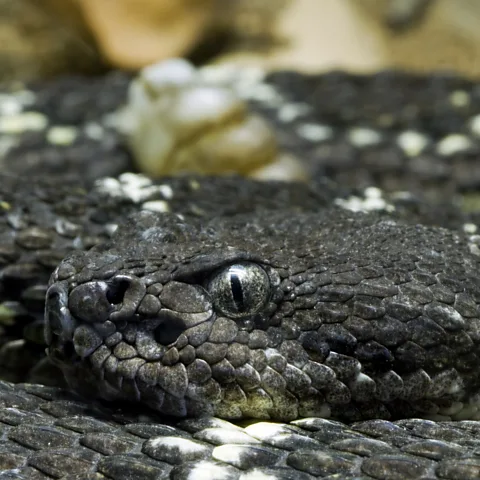'You're supposed to hate snakes - I don't': The rescuers saving Arizona's rattlesnakes
 Getty Images
Getty ImagesReports of human-snake encounters are on the rise – and some people react to a snake on their property by killing it. But is there a better way, for both people and the reptiles?
The rattlesnake hotline call handler had a question. Could Christa Reinach see whether the 3ft-long (1m) snake, currently stretched out on her patio, had black and white bands on its tail?
"Yes," said Reinach, eyeing the creature through her window. While the call handler couldn't be sure, those markings likely meant that Reinach had a venomous western diamondback rattlesnake on her property. A snake relocator would be there as soon as possible.
Reinach sat back and waited. Although a bite could potentially be fatal, she wasn't overly worried by the rattlesnake herself. And her dogs, two Chinese Shar-Peis, were safely locked inside the house. Reinach lives in Rio Verde Foothills, a community near Scottsdale, Arizona. Because this community is right by the desert, she had every expectation that snakes would appear on her land from time to time.
But she didn't want the snake sticking around for too long – particularly because of her horses, who might put their heads to the ground to inspect a snake, only to get bitten on the nose. "If the nose swells, then they cannot breathe," Reinach says.
Between 7,000-8,000 people are bitten by a venomous snake every year in the US; around five die. Pets are even more likely to suffer a bite, and to be killed by it. Of all US snake species, rattlesnakes are among the most dangerous. In a study of snakebites affecting 11,138 patients, published in 2019, the type of snake that caused the bite was identifiable in roughly half of those cases – and within that group, the most common bite was a rattlesnake bite. The US Centers for Disease Control and Prevention say that, for anyone bitten by a rattlesnake, 10-44% will have lasting injuries, such as losing a finger.
As property developers push further into snake habitats, the potential for human-snake encounters is on the rise, according to experts who spoke to the BBC. Climate change may also have an impact. It is eroding some snakes' habitats – as well as making them more likely to seek out, say, a cool garden on a hot day. But snakes play a crucial role in local ecosystems. Experts say that simply killing every snake that winds up on human property isn't just unethical; ultimately, it could cause problems for humans, too.
In certain cases, euthanising snakes is desirable, such as when invasive species begin taking too great a toll on native wildlife. Humanely killing those invasive snakes after capturing them can help to keep the ecosystem in balance.
 Rattlesnake Solutions
Rattlesnake SolutionsBut in Arizona and other parts of the US, some organisations are working to capture and relocate native snakes alive. Homebuilding projects in the state have expanded into desert areas, replacing shrubs with residential buildings. It means that people are increasingly living in rattlesnake hotspots. Local data suggests a steady rise in bite reports in recent years.
That's where Rattlesnake Solutions comes in. This local firm endeavours to rescue and move snakes when they're discovered somewhere that could pose a threat to humans or pets. The company indicates that rattlesnake relocation requests appear to be rising in certain mountainous residential areas.
It was Rattlesnake Solutions' number that Christa Reinach dialled when she found the eastern diamondback on her property last April. Not long after she made the call, a member of the company's team came out to her ranch.
Reinach watched as the snake rescuer gently scooped the rattlesnake up, aided by a reassuringly long pair of snake tongs, before setting the animal inside a large container with a fitted lid. Holes in the barrel ensured the snake wouldn't run out of air. The rescuer took the snake into the desert, where there are plenty of dens for it to hide in and rodents for it to hunt. A place where there are no patio lights overhead, just thousands of stars.
Reinach was happy with how everything went. "I really don't believe in killing anything when it is just out of place," she says.
Rattlesnake relocators take this approach not just because some people think native snakes are neat. Such snakes, actually, do a lot of good.
They eat rodents, helping to keep mice populations under control, for example. This is particularly beneficial to farmers, since large numbers of mice can devour astonishing amounts of grain. One Australian study estimated that populations of eastern brown snakes can remove thousands of mice per square kilometre of farmland every year. Rattlesnakes in North America play a similar role.
They might also help plant life by dispersing seeds. In 2018, US researchers published a study that showed how rattlesnakes sometimes consume seeds indirectly, by eating rodents carrying seeds in their mouths. By later excreting the seeds, the same snakes could help plants to grow in new areas.
Rattlesnake predation might even reduce the incidence of Lyme disease, which is spread by biting insects called ticks – snakes eat small mammals that ticks like to feed on.
But despite these benefits, some snake species are currently under threat. Numbers of the eastern diamondback rattlesnake are declining, for instance, and the Arizona black rattlesnake is potentially headed towards extinction. A 2022 study suggested that temperature rises caused by climate change will reduce the suitable habitat available to 71% of US rattlesnake species between now and 2040.
Living with snakes
Bryan Hughes was about five years old when he first held a snake in his hands. Members of a local herpetological society – a group that studies and looks after reptiles and amphibians – had brought a scarlet kingsnake to a nature centre near where he lived at the time, in Oregon. It was small but incredibly beautiful. Hughes marvelled at the reptile's rich red, creamy yellow and jet-black bands of colour. It was so shiny and clean, it almost looked wet.
"It just seemed so cool," he recalls. Searching for the words to explain the effect it had on him, he adds, "Holding that animal at that time felt like – it just hit something." After that, Hughes checked out every book about snakes from the library that he could find. Before long, he was looking for snakes in the wild. It felt like treasure hunting, he says.
 Getty Images
Getty ImagesAfter losing his marketing job following the 2008 financial crisis, he decided to try and make a living out of his fascination with snakes. Although he had no formal training, he had spent time volunteering for a herpetological association where he would rescue and relocate snakes that found their way into someone's garden or garage. There was so much demand that Hughes decided to launch a similar service as a business. He put together a logo, launched a website and, almost overnight, Rattlesnake Solutions was born.
Since then, Hughes and his colleagues in Arizona have relocated thousands of snakes – he estimates "around 20,000" in total, or roughly 1,500 a year – and Hughes has co-authored multiple scientific papers about rattlesnake encounters. Each snake relocation costs a homeowner around $150 (£113) and the work, from capture to release, typically takes about two hours.
There are many different species of snake native to Arizona, including multiple venomous rattlesnakes. The most common callouts are triggered by western diamondbacks and non-venomous Sonoran gopher snakes, both of which can grow to 6ft (2m) in length – making them pretty hard to miss should they slither into someone's garden.
Hughes says he and his colleagues always try to tell homeowners about the snake that they have been called in to capture. It is a key opportunity to inform a homeowner about the species they are dealing with, or to give advice on how to behave around venomous snakes. It's also a chance for an upsell. Rattlesnake Solutions offers a form of fencing that, when dug partially into the ground, can seal off the perimeter of a property from serpentine callers.
"The harder task is making sure the snake lives and isn't immediately a problem for somebody else," explains Hughes. "We need to find the right hole in the ground to put the snake in, or it will die." Rattlesnake Solutions aims to reach such a location within minutes or hours of retrieving a snake.
Part of the reason for the rise in snake encounters that Hughes and his colleagues have detected, he says, is because housing developers are repeatedly making "the same mistakes". They use large piles of rocks to protect tracts of land from eroding away during storms – but this makes a perfect hiding place for snakes. Also, developers often plant gardens full of leafy shrubs that require artificial watering. Snakes enjoy sheltering beneath those moist, cool plants.
Climate change is exacerbating the consequences of such mistakes. Hotter summers mean snakes – which don't have an internal system to regulate their body temperature – are more likely to seek shelter in people's lush gardens. In 2023, a record was broken in Phoenix, Arizona for the number of consecutive days, 55, at or above 110F (43.3C).
 Getty Images
Getty ImagesPlus, when the weather is hot and sunny – so long as it is not dangerously hot – people often spend more time outdoors. These trends mean that snakes and people are encountering each other more often. The frequency of those encounters and snakebites, too, might only continue to rise.
But humans need to learn to live alongside snakes, experts say.
"Rattlesnakes and people can coexist," says Emily Taylor, a snake specialist at Cal Poly in California who carries out native species snake relocations herself, on a voluntary basis. She describes Bryan Hughes as a friend but says she has no commercial connection to his company. She agrees that extensive residential home construction in desert areas is likely to promote encounters between people and snakes.
Back in Arizona, more homeowners might catch sight of a rattlesnake on their land in the coming years. Every spring, in particular, the snakes roam far and wide, looking for mates. Reinach, for one, accepts this. "We live in the desert," she says. "The snakes are just part of that ecology."
When they appear on TV or in movies, rattlesnakes are often sensationalised. They're depicted as menacing and vicious. Bryan Hughes, who has never got over his fascination with them, knows better. Rattlesnakes are wild animals whose lives are increasingly at risk from the expansion of human civilisation, and a society that doesn't really understand these reptiles.
"You're supposed to hate these things, you're supposed to kill these things – well, I don't," says Hughes. "I want to save them."
--
For essential climate news and hopeful developments to your inbox, sign up to the Future Earth newsletter, while The Essential List delivers a handpicked selection of features and insights twice a week.
